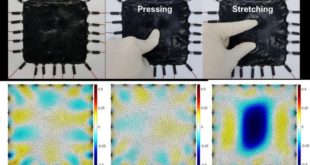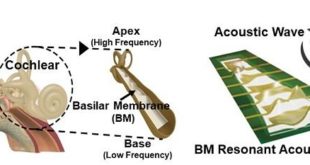KAIST researchers have developed a novel wearable strain sensor based on the modulation of optical transmittance of a carbon nanotube (CNT)-embedded elastomer. The sensor is capable of sensitive, stable, and continuous measurement of physical signals. This technology, featured in ACS Applied Materials & Interfaces, shows great potential for the detection …
Read More »True-meaning wearable displays: Self-powered, washable and wearable
When we think about clothes, they are usually formed with textiles and have to be both wearable and washable for daily use; however, smart clothing has had a problem with its power sources and moisture permeability, which causes the devices to malfunction. This problem has now been overcome by a …
Read More »High-performance flexible transparent force touch sensor
Researchers from KAIST have reported a high-performance and transparent nanoforce touch sensor by developing a thin, flexible, and transparent hierarchical nanocomposite (HNC) film. The research team says their sensor simultaneously features all the necessary characters for industrial-grade application: high sensitivity, transparency, bending insensitivity, and manufacturability. Force touch sensors that recognise …
Read More »Spray coated tactile sensor on a 3D surface for robotic skin
Robots will be able to conduct a wide variety of tasks as well as humans if they can be given tactile sensing capabilities. A KAIST research team has reported a stretchable pressure insensitive strain sensor by using an all solution-based process. The solution-based process is easily scalable to accommodate for …
Read More »Flexible piezoelectric acoustic sensors for speaker recognition
A KAIST research team led by Professor Keon Jae Lee from the Department of Material Science and Engineering has developed a machine learning-based acoustic sensor for speaker recognition. Acoustic sensors were spotlighted as one of the most intuitive bilateral communication devices between humans and machines. However, conventional acoustic sensors use …
Read More » Instrumentation Monthly Test | Measurement | Control
Instrumentation Monthly Test | Measurement | Control




